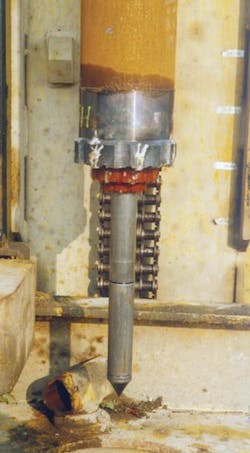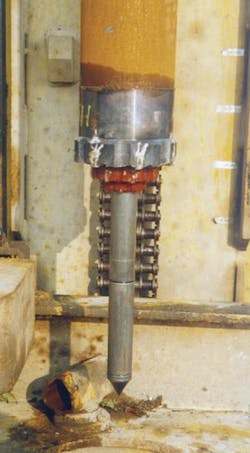Seabed Investigations - Simultaneous CPTs while drilling
A new technique for carrying out cone penetration test measurements while drilling proceeds – CPTWD – has been developed by Environmental Mechanics (Envi). It will be launched later this year, according to President Kjell Elmgren.
CPTWD is a combination of the cone penetration test (CPT) technique with rotary drilling. But whereas CPT is conventionally performed in 3-m steps, making it a time-consuming business, CPTWD allows drilling and testing to take place simultaneously, enabling greater distances to be covered in the same time. In trial operations CPTWD has been used to depths of 130 m, while CPT does not normally go below 50 m, Elmgren says.
The key to CPTWD is preventing the CPT probe, the Memocone, from rotating along with the drill-bit. This is achieved by a bearing arrangement. The 3-6 mm probe, which protrudes about half a meter in front of the drill bit, would be damaged if pushed into harder layers; so once the pressure exceeds a threshold of five tonnes, it is retracted behind the drill-bit.
Data on resistance, friction, and pore-water pressure are collected by the battery-operated probe and stored in an internal memory. When the probe has been retrieved to the surface, the data are downloaded into Envi's D-mon data logger.
D-mon – it stands for drilling monitor – has been designed as a user-friendly tool, Elmgren says. Instead of requiring the driller to keep an eye on a series of gauges giving the readings for the different parameters – bit load, rate of penetration, torque, revolutions per minute, and flush pressure – readings are presented in a simplified, one-picture display. A safety feature triggers an alarm if any of the parameters exceeds a critical limit, allowing time for emergency action to be taken.
null
The logger was first used in the construction of the Channel Tunnel in a process called tunneling probing. Probe drilling with data logging was performed 100-150 m ahead of the drilling machine to locate faults and take measurements.
Envi's Italian partner SPG has worked out a formula that allows drilling data to be interpreted to show variations in the softness and hardness of the different layers.
The logging technique is aimed at small-scale drilling operations. Equivalent techniques are already in use on large drilling rigs. However, there is a significant cost difference, as D-mon costs between one-tenth and one-twentieth of the equivalent logging systems used on large rigs, Elmgren says.
For more information, contact Kjell Elmgren, Environmental Mechanics. Tel +46 322 67 03 31, fax +46 322 63 67 56. [email protected], www.envi.se

